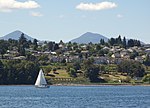Nanaimo Airport
Buildings and structures in NanaimoCertified airports in British ColumbiaTransport in Nanaimo

Nanaimo Airport (IATA: YCD, ICAO: CYCD) is a privately owned and operated regional airport located 7 nautical miles (13 km; 8.1 mi) south southeast of Nanaimo, British Columbia, Canada. In 1999, the air terminal was named in honour of World War I ace Raymond Collishaw who was born in Nanaimo. The Nanaimo-Collishaw Air Terminal is the passenger terminal for the airport. The Nanaimo Airport currently has only one available runway for instrument flight rules (IFR) conditions, runway 16. This is because the approach to the north-facing runway (runway 34) is a dogleg approach that follows the Ladysmith Harbour.
Excerpt from the Wikipedia article Nanaimo Airport (License: CC BY-SA 3.0, Authors, Images).Nanaimo Airport
Spitfire Road, Area A (Cassidy/Cedar)
Geographical coordinates (GPS) Address Website External links Nearby Places Show on map
Geographical coordinates (GPS)
| Latitude | Longitude |
|---|---|
| N 49.054444444444 ° | E -123.87 ° |
Address
Nanaimo Airport
Spitfire Road 3350
V0R 1H0 Area A (Cassidy/Cedar)
British Columbia, Canada
Open on Google Maps






